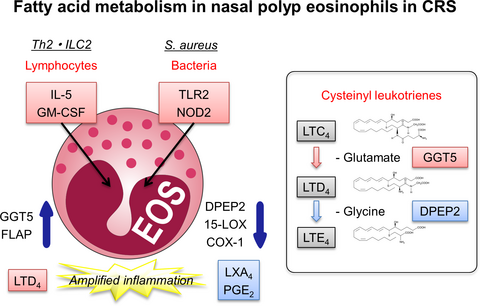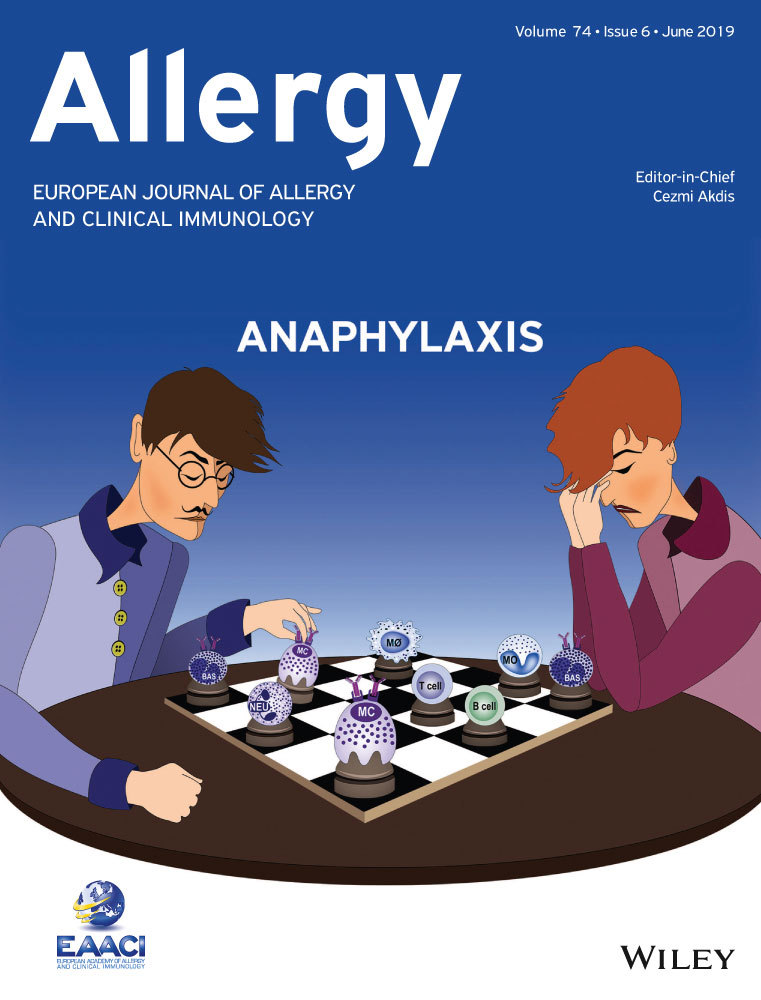Dysregulated fatty acid metabolism in nasal polyp-derived eosinophils from patients with chronic rhinosinusitis
Funding information
This work was supported in part by RIKEN Special Postdoctoral Researchers Program (to J.M.), Japan Society for the Promotion of Science KAKENHI JP15H05897, 15H05898, 15H04648 (to M.A.), JP26461197 (to K.F.), Japan Science and Technology Agency Precursory Research for Embryonic Science and Technology (PRESTO) (to M.A.), and Ono Pharmaceutical Company.
Abstract
Background
Eosinophils are multifunctional granulocytes capable of releasing various cytokines, chemokines, and lipid mediators. We previously reported dysregulated fatty acid metabolism in peripheral blood-derived eosinophils from patients with severe asthma. However, functional characteristics of eosinophils present in allergic inflammatory tissues remain largely uncharacterized.
Methods
We established a method for isolating CD69hi CCR3low CXCR4- siglec-8int eosinophils from nasal polyps of patients with eosinophilic rhinosinusitis (NP-EOS). Multi-omics analysis including lipidomics, proteomics, and transcriptomics was performed to analyze NP-EOS as compared to peripheral blood-derived eosinophils from healthy subjects (PB-EOS).
Results
Lipidomic analysis revealed impaired synthesis of prostaglandins and 15-lipoxygenase (15-LOX)-derived mediators, and selective upregulation of leukotriene D4 production. Furthermore, proteomics and transcriptomics revealed changes in the expression of specific enzymes (GGT5, DPEP2, and 15-LOX) responsible for dysregulated lipid metabolism. Ingenuity pathway analysis indicated the importance of type 2 cytokines and pattern recognition receptor pathways. Stimulation of PB-EOS with eosinophil activators IL-5, GM-CSF, and agonists of TLR2 and NOD2 mimicked the observed changes in lipid metabolism.
Conclusion
Inflammatory tissue-derived eosinophils possess a specific phenotype with dysregulated fatty acid metabolism that may be targeted therapeutically to control eosinophilic inflammatory diseases.
Graphical Abstract
Eosinophils isolated from nasal polyps of patients with eosinophilic rhinosinusitis possess dysregulated fatty acid metabolism. Of the CysLT (cysteinyl leukotriene) biosynthetic pathway metabolites, LTD4 production is selectively enhanced with increased expression of GGT5 (gamma-glutamyl trasferase-5) and decreased expression of DPEP2 (dipeptidase-2). Type 2 cytokines (IL-5 and GM-CSF) and agonists of TLR2 and NOD2 induce similar changes of fatty acid metabolism.
COX: Cyclooxygenase; CRS: Chronic rhinosinusitis; DPEP2: Dipeptidase-2; GGT5: Gamma-glutamyl trasferase-5; GM-CSF: Granulocyte-macrophage colony-stimulating factor; ILC2: Type 2 innate lymphoid cells; LTC4: Leukotriene C4; LTD4: Leukotriene D4; LTE4: Leukotriene E4; LXA4: Lipoxin A4; NOD2: Nucleotide binding oligomerization domain containing 2; PGE2: Prostaglandin E2; Th2: Type 2 helper T cells; TLR2: Toll-like receptor 2
CONFLICTS OF INTEREST
The authors declare that they have no conflicts of interest.





